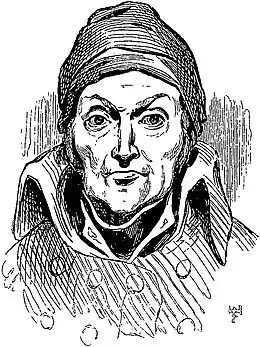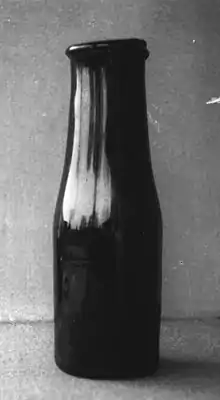Nicolas Appert
Nicolas Appert (17 November 1749 – 1 June 1841) was the French inventor of airtight food preservation. Appert, known as the "father of canning", was a confectioner.[1] Appert described his invention as a way "of conserving all kinds of food substances in containers".[2]
Nicolas Appert | |
|---|---|
 Nicolas Appert 1841 | |
| Born | 17 November 1749 Châlons-sur-Marne, Kingdom of France |
| Died | 1 June 1841 (aged 91) |
| Nationality | French |
| Signature | |
 | |
Early life
Appert was born in Châlons-en-Champagne, the ninth of eleven children. His family ran an inn in the town and he worked in the family business until the age of twenty, when he opened a brewery with one of his brothers. He then served as head chef to Christian IV, Count Palatine of Zweibrücken for thirteen years. Appert was a confectioner and chef in Paris from 1784 to 1795. During this period, he married Elisabeth Benoist and the couple had four children.[3]
Appert was active during the French Revolution and even took part in the execution of King Louis XVI. However, he fell under suspicion during the subsequent Reign of Terror and was arrested in April 1794, but he was able to avoid being executed himself.[4] In 1795, he began experimenting with ways to preserve foodstuffs, succeeding with soups, vegetables, juices, dairy products, jellies, jams, and syrups. He placed the food in glass jars, sealed them with cork and sealing wax and placed them in boiling water (in later years, he switched to using an autoclave). It is believed that this technique was already being used by homemakers, but Appert was the first to do this on an industrial scale.[5][6]
Canning

In 1804, La Maison Appert (English: The House of Appert), in the town of Massy, near Paris, became the first food bottling factory in the world,[6] years before Louis Pasteur proved that heat killed bacteria. Appert then established a business to preserve a variety of food in sealed bottles. Appert's method was to fill thick, large-mouthed glass bottles with produce of every description, ranging from beef, fowl, eggs, milk, and prepared dishes.[7] Appert deliberately avoided using tinplate in his early manufacture because the quality of French tinplate was poor.[8] He left air space at the top of the bottle, and the cork would then be sealed firmly in the jar by using a vise. The bottle was then wrapped in canvas to protect it, while it was dunked into boiling water and then boiled for as much time as Appert deemed appropriate for cooking the contents thoroughly.[9] In honor of Appert, canning is sometimes called "appertization", which is distinct from pasteurization.[10]
Despite his successes, Appert had financial troubles due to the high cost of his equipment and the fact that he was not a very good businessman. He declared bankruptcy in 1806, but was able to continue his business.[11] In 1795, the French army had offered a prize of 12,000 francs for a new method to preserve food.[12] In 1806 Appert presented a selection of bottled fruits and vegetables from his manufacture at the Exposition des produits de l'industrie française, but did not win any reward.[7] In 1810 the Bureau of Arts and Manufactures of the Ministry of the Interior gave Appert an ex gratia payment of 12,000 francs on condition that he make his process public.[lower-alpha 1] Appert accepted and published a book describing his process that year.[1] Appert's treatise was entitled L'Art de conserver les substances animales et végétales (The Art of Preserving Animal and Vegetable Substances),[14] 6,000 copies of which were printed in 1810.[15] This was the first book of its kind on modern food preservation methods.[16]
Although Appert never truly understood why his method worked (this being years before the science of bacteriology was developed),[1] it was so simple that it quickly became widespread. In 1810, British inventor and merchant Peter Durand patented his own method, but this time in a tin can, so creating the modern-day process of canning foods. In 1812 Englishmen Bryan Donkin and John Hall purchased both patents and began producing preserves.[17]
Later life
However, despite the government grant, his financial situation did not improve and was exacerbated by the destruction of his factory at Massy by Prussian and Austrian forces at the end of the War of the Sixth Coalition in 1814.[11] With the support of the French government in the form of free rent, he opened a new factory in Paris to preserve food in tin cans, which lasted for ten years until the same government evicted him in December 1827.[18]
Appert's canned goods were widely appreciated, especially by naval services as the products were far superior to the dried and salted provisions they had previously relied on. Cans were exported to Bavaria and Saint Petersburg, and received praise from newspapers across France. However, this did not translate into financial success. Despite silver and gold medals from the Société d'encouragement pour l'industrie nationale in 1816 and 1820 respectively, it was not until 1824 that he received the 2,000 francs associated with them.[19]
In 1828, he opened yet another factory in the city. He petitioned Louis Philippe I for entry into the Legion of Honour but was denied, possibly due to his activities during the Revolution.[15] Taking this as an insult, he retired in 1836 at the age of 86.[11] Despite a pension of 1,200 francs a year from the government beginning that year,[13] he died in poverty in 1841 and was buried in a pauper's grave.[9]
Posthumous honors
In 1955 a French postal stamp commemorated him.[20][21]
In 1991, a monumental statue of Appert, a work in bronze by the artist Jean-Robert Ipousteguy, was erected in Châlons-en-Champagne.[22] A plaque was affixed to his birthplace in 1986.
A room in the Musée des Beaux-Arts et d'Archéologie de Châlons-en-Champagne was dedicated to him.[23]
There is a high school named after Nicolas Appert in Orvault, France.[24]
2010 was declared Nicolas Appert Year, a national celebration, by the French ministry of culture. The Principality of Monaco issued a postage stamp featuring Appert. An exhibition entitled "Mise en boîte" was held at the Musée des Beaux-Arts et d'Archéologie de Châlons-en-Champagne.[25]
Nicolas Appert Award
Since 1942, each year the Chicago section of the Institute of Food Technologists has awarded the Nicolas Appert Award, recognizing lifetime achievement in food technology.[26]
Study association
The student association of the Food Technology education at Wageningen University is called Nicolas Appert. Since 1972 this association has focused on improving the courses related to food technology education and organises several events each year for students and alumni. Currently almost 900 bachelor and master students are members. In 2017 the association celebrated its 11th lustrum.[27]
Notes
- In comparison, the average French worker made a daily wage of three francs.[13]
References
- Encyclopedia of World Biography.
- Robertson 1998, p. 174.
- Garcia & Adrian 2009, pp. 115–116.
- Garcia & Adrian 2009, p. 116.
- Garcia & Adrian 2009, pp. 117–118.
- Day & McNeil 1996.
- Garcia & Adrian 2009, p. 120.
- Robertson 1998, p. 175.
- Garcia & Adrian 2009, p. 118.
- Adams, M. R.; Moss, M. O. (2008). Food Microbiology. Royal Society of Chemistry. p. 65. ISBN 978-0-85404-284-5.
- Evans 2000.
- Eschner, Kat. "The Father of Canning Knew His Process Worked, But Not Why It Worked". Smithsonian Magazine. Retrieved 15 November 2020.
- Garcia & Adrian 2009, p. 121.
- Norman 2017.
- Garcia & Adrian 2009, p. 122.
- Wiley 1994, p. 66.
- Gordon L. Robertson (2006). Food packaging. CRC Press. p. 123. ISBN 978-0-8493-3775-8.
- Garcia & Adrian 2009, pp. 117–118, 122.
- Garcia & Adrian 2009, pp. 121–122.
- Tin and Its Uses. Tin Research Institute. 1955. p. 13.
The stamp shown in our illustration was issued in honour of Nicolas Appert in France on March 5th, 1955.
- "France – 12fr stamp of 1955 (#44531)". StampData. Retrieved 15 November 2020.
- "Nicolas Appert Biography – Tourism Châlons-en-Champagne". Châlons en Champagne Tourist Office. Retrieved 15 November 2020.
- "Musée des Beaux-Arts et d'Archéologie de Châlons-en-Champagne". City of Châlons-en-Champagne (in French). Retrieved 15 November 2020.
- "Lycée Nicolas Appert". appert.paysdelaloire.e-lyco.fr (in French). Retrieved 15 November 2020.
- Barbier, Jean-Paul (December 2009). "Appert et l'invention de la conserve". Fondation Napoléon (in French). Retrieved 15 November 2020.
- "Lifetime Achievement Award in Honor of Nicolas Appert". Institute of Food Technologists. Retrieved 15 November 2020.
- nicolasappert.com (in Dutch and English) and some parts in Chinese
Sources
- Garcia, Rebeca; Adrian, Jean (2009), "Nicolas Appert: Inventor and Manufacturer", Food Reviews International, 25 (2): 115–125, doi:10.1080/87559120802682656, S2CID 83865891, retrieved 11 October 2017
- Barbier, Jean-Paul (1994), Nicolas Appert inventeur et humaniste (in French), Paris: Royer, ISBN 2-908670-17-8
- Day, Lance; McNeil, Ian, eds. (1996). Biographical Dictionary of the History of Technology. Routledge. ISBN 0-415-19399-0.
- Evans, Lindsay (2000), Neil, Schlager; Josh, Lauer (eds.), "Nicolas Appert", Science and Its Times: Understanding the Social Significance of Scientific Discovery, ISBN 978-0787639327 – via Encyclopedia.com
- Norman, Jeremy (2 September 2017), "Nicholas Appert Issues the First Book on Modern Food Preservation Methods", HistoryofInformation.com, retrieved 11 October 2017
- Robertson, Gordon L. (1998), Food Packaging: Principles and Practice, Marcel Dekker, ISBN 9780824701758
- Wiley, R.C. (30 April 1994), Minimally Processed Refrigerated Fruits & Vegetables, Springer Science & Business Media, ISBN 978-0-412-05571-3, retrieved 11 October 2017
- "Nicolas Appert", Encyclopedia of World Biography – via Encyclopedia.com
External links
| Wikimedia Commons has media related to Nicolas Appert. |